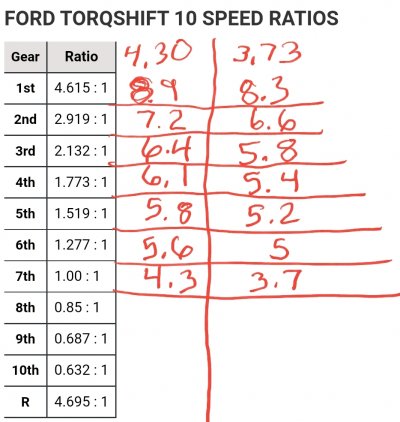ramffml
Senior Member
- Joined
- Jul 12, 2019
- Posts
- 2,808
- Reaction score
- 5,134
- Location
- ramforum
- Ram Year
- 2019
- Engine
- hemi 5.7
You obviously don't understand how rear end gearing works. Every single gear of the transmission is affected by the rear end gear. 6th is lower going through a 4.30 rear than a 3.73 rear, 4th is too, so is 1-10. All gears benefit from the lower 4.30 rear end gear.
Glad I could clear that up for you.
Your mistake (very common) is in thinking that the truck will be using the same gear number for a given speed, that it used to before the change. It won't. Gear shifts are driven by load and rpm.
So if you used to climb a hill in 4th with the 3.73, at 2000 rpms, after the swap to 4.30 your truck might take that same hill in 5th at approx 2000 rpms. You gained nothing, all you did was change what transmission gear number your using to perform the work.
Imagine your truck rear end was very "high end" and could be shifted from a 2.50 to 3.10 to 3.50 to 4.10 to 4.30. Wouldn't that be cool, you can pick whatever gear in the back you need? But that is exactly what your tranmission does. 10 gears is impressively cool, you don't need to worry about rear end at that point because your transmission will downshift to whatever gear you need, to make sure your RPMs are just high enough to make enough power to handle the current load.


